Forest Fire Causes and Motivations in the Southern and South-Eastern Europe through Experts’ Perception and Applications to Current Policies
Abstract
:1. Introduction
2. Materials and Methods
2.1. Study Area
2.2. The EU Harmonized Classification of Forest Fire Causes
2.3. Fire Experts Survey
2.4. EFFIS Forest Fire Data
- A.
- Reported yearly totals of number of fires and burnt area supplied by the contributing countries and published every year in the Forest Fires in Europe, North Africa and Middle East Reports (e.g., [9]). These data are considered official as they are directly provided by the national authorities. They may differ among countries in how they are reported, for instance, when the definition of forest fire differs. For this dataset, no data are available for Bosnia and Herzegovina and Serbia.
- B.
- Regional yearly fire statistics computed from the individual fire events supplied by the contributing countries were aggregated according to ignition categories (raw data of single fires are currently not publicly available). These data display differences not only among but also within single countries on the recording protocol (e.g., only in public state forests or only in the most fire-prone regions). As a result, totals may show discrepancies with respect to the yearly data reported in the option A. For this dataset, no data are available for Bosnia and Herzegovina, Serbia, and the Republic of North Macedonia.
- C.
- Yearly statistics resulting from systematic large fire mapping (usually greater than 30 hectares) by EFFIS, based on satellite imagery.
2.5. Data Processing and Analysis
3. Results and Discussion
3.1. Unknown Causes
3.2. Known Causes
3.3. Subcategories of the Known Causes as Perceived by Experts
3.3.1. Natural Causes
3.3.2. Accident Causes
3.3.3. Negligent Use of Fire
3.3.4. Use of Glowing Objects
3.3.5. Deliberate Causes
3.3.6. Rekindle
3.4. Rank of Motivations
3.5. Cluster Analysis
4. Concluding Remarks
Supplementary Materials
Author Contributions
Funding
Data Availability Statement
Acknowledgments
Conflicts of Interest
References
- Keeley, J.E.; Bond, W.J.; Bradstock, R.A.; Pausas, J.G.; Rundel, P.W. Fire in Mediterranean Ecosystems: Ecology, Evolution and Management; Cambridge University Press: Cambridge, NY, USA, 2011; ISBN 978-0-521-82491-0. [Google Scholar]
- Turco, M.; Bedia, J.; Di Liberto, F.; Fiorucci, P.; Von Hardenberg, J.; Koutsias, N.; Llasat, M.C.; Xystrakis, F.; Provenzale, A. Decreasing Fires in Mediterranean Europe. PLoS ONE 2016, 11, e0150663. [Google Scholar] [CrossRef] [PubMed] [Green Version]
- Darques, R. Wildfires at a pan-mediterranean scale: Human-environment dynamics through MODIS data. Hum. Ecol. 2016, 44, 47–63. [Google Scholar] [CrossRef]
- Vélez, R. Community Based Fire Management in Spain, April 2005; Forest Protection Working Papers: Rome, Italy, 2005. [Google Scholar]
- Castellnou, M.; Miralles, M. The great fire changes in the Mediterranean—The example of Catalonia, Spain. Cris. Response 2009, 5, 56–57. [Google Scholar]
- Tedim, F.; Leone, V.; Amraoui, M.; Bouillon, C.; Coughlan, M.; Delogu, G.; Fernandes, P.; Ferreira, C.; McCaffrey, S.; McGee, T.; et al. Defining Extreme Wildfire Events: Difficulties, Challenges, and Impacts. Fire 2018, 1, 9. [Google Scholar] [CrossRef] [Green Version]
- Tedim, F.; Xanthopoulos, G.; Leone, V. Forest Fires in Europe: Facts and Challenges. In Wildfire Hazards, Risks and Disasters; Paton, D., Buergelt, P., Tedim, F., McCaffrey, S., Eds.; Elsevier: Amsterdam, The Netherlands, 2015; pp. 77–99. ISBN 9780124104341. [Google Scholar]
- San-Miguel-Ayanz, J.; Oom, D.; Artes, T.; Viegas, D.X.; Fernandes, P.; Faivre, N.; Freire, S.; Moore, P.; Rego, F.; Castellnou, M. Forest fires in Portugal in 2017. In Science for Disaster Risk Management 2020: Acting Today, Protecting Tomorrow; Casajus Valles, A., Marin Ferrer, M., Poljanšek, K., Clark, I., Eds.; Publications Office of the European Union: Luxemburg, 2020; pp. 414–430. ISBN 978-92-76-18182-8. [Google Scholar]
- San-Miguel-Ayanz, J.; Durrant, T.; Boca, R.; Maianti, P.; Libertà, G.; Artés Vivancos, T.; Oom, D.; Branco, A.; Tomàs Rigo, D.; Ferrari, D.; et al. Forest Fires in Europe, Middle East and North Africa 2020; EUR 30862 EN; Publications Office of the European Union: Luxembourg, 2021. [Google Scholar]
- Camia, A.; Durrant Houston, D.; San-Miguel-Ayanz, J. Harmonized Classification Scheme of Fire Causes in the EU Adopted for the European Fire Database of EFFIS; EUR 25923; Publications Office of the European Union: Luxembourg, 2013. [Google Scholar]
- Prestemon, J.P.; Chas-Amil, M.L.; Touza, J.M.; Goodrick, S.L.; Prestemon, J.P.; Chas-Amil, M.L.; Touza, J.M.; Goodrick, S.L. Forecasting intentional wildfires using temporal and spatiotemporal autocorrelations. Int. J. Wildl. Fire 2012, 21, 743–754. [Google Scholar] [CrossRef]
- Martínez Navarro, J.M. La Gestión Territorial del Riesgo Antrópico de Ignición Forestal en Castilla-La Mancha; Universidad de Castilla-La Mancha: Cuenca, Spain, 2018. [Google Scholar]
- Meddour-Sahar, O. Wildfires in Algeria: Problems and challenges. iForest Biogeosci. For. 2015, 8, 818–826. [Google Scholar] [CrossRef] [Green Version]
- San-Miguel-Ayanz, J.; Durrant, T.; Boca, R.; Liberta’, G.; Branco, A.; De Rigo, D.; Ferrari, D.; Maianti, P.; Artes Vivancos, V.; Pfeiffer, P.; et al. Forest Fires in Europe, Middle East and North Africa 2018; Publications Office of the European Union: Luxembourg, 2019. [Google Scholar]
- Leone, V.; Lovreglio, R. Metodo delle Evidenze Fisiche (M.E.F.): Guida Operativa di Campo. Collana Verde: Metodologie Tecniche Operative nel Contrasto ai Reati di Incendio Boschivo; Corpo Forestale dello Stato: Roma, Italy, 2010. [Google Scholar]
- Ganteaume, A.; Guerra, F. Explaining the spatio-seasonal variation of fires by their causes: The case of southeastern France. Appl. Geogr. 2018, 90, 69–81. [Google Scholar] [CrossRef]
- Ganteaume, A.; Camia, A.; Jappiot, M.; San-Miguel-Ayanz, J.; Long-Fournel, M.; Lampin, C. A review of the main driving factors of forest fire ignition over Europe. Environ. Manag. 2013, 51, 651–662. [Google Scholar] [CrossRef] [Green Version]
- Leone, V.; Koutsias, N.; Martínez, J.; Vega-García, C.; Allgöwer, B.; Lovreglio, R. The Human Factor in Fire Danger Assessment. In Wildland Fire Danger Estimation and Mapping The Role of Remote Sensing Data; Chuvieco, E., Ed.; World Scientific Publishing: Hackensack, NJ, USA, 2003; Volume 4, pp. 143–196. ISBN 978-981-279-117-7. [Google Scholar]
- Calviño-Cancela, M.; Cañizo-Novelle, N. Human dimensions of wildfires in NW Spain: Causes, value of the burned vegetation and administrative measures. PeerJ 2018, 6, e5657. [Google Scholar] [CrossRef]
- Conedera, M. Implementing Fire History and Fire Ecology in Fire Risk Assessment: The Study Case of Canton Ticino (Southern Switzerland). Ph.D. Thesis, Institut für Geographie und Geoökologie (IFGG), Universität Fridericiana zu Karlsruhe, Karlsruhe, Germany, 2009. [Google Scholar]
- Conedera, M.; Cesti, G.; Pezzatti, G.B.; Zumbrunnen, T.; Spinedi, F. Lightning-induced fires in the Alpine region: An increasing problem. In Proceedings of the V International Conference on Forest Fire Research, Coimbra, Portugal, 27–30 November 2022; CEIF—Centro de Estudos Sobre Incêndios Florestais: Coimbra, Portugal; ADAI—Associação para o Desenvolvimento da Aerodinâmica, Industrial: Coimbra, Portugal, 2006; p. 9. [Google Scholar]
- van Vuuren, D.P.; Edmonds, J.; Kainuma, M.; Riahi, K.; Thomson, A.; Hibbard, K.; Hurtt, G.C.; Kram, T.; Krey, V.; Lamarque, J.F.; et al. The representative concentration pathways: An overview. Clim. Chang. 2011, 109, 5–31. [Google Scholar] [CrossRef]
- European Environment Agency. Climate Change Adaptation and Disaster Risk Reduction in Europe; European Environment Agency: Copenhagen, Denmark, 2017. [Google Scholar]
- Blinder, A.S.; Morgan, J. Are Two Heads Better Than One? An Experimental Analysis of Group vs. Individual Decisionmaking. Natl. Bur. Econ. Res. 2000. [Google Scholar] [CrossRef]
- Grime, M.M.; Wright, G. Delphi Method. Wiley StatsRef Stat. Ref. Online 2016, 1–6. [Google Scholar] [CrossRef]
- Rowe, G.; Wright, G. The Delphi technique as a forecasting tool: Issues and analysis. Int. J. Forecast. 1999, 15, 353–375. [Google Scholar] [CrossRef]
- Weaver, W.T. The Delphi Forecasting Method. Phi Delta Kappan 1971, 52, 267–271. [Google Scholar]
- Dalkey, N.C. The Delphi method: An experimental study of group opinion. In Tudies in the Quality of Life: Delphi and Decision-Making; Rourke, D.L., Lewis, R., Snyder, D., Eds.; Lexington Books: Lexington, MA, USA, 1972; pp. 13–54. [Google Scholar]
- Dalkey, N.; Helmer, O. An Experimental Application of the Delphi Method to the Use of Experts. Manag. Sci. 1963, 9, 458–467. [Google Scholar] [CrossRef]
- Baughman, M.J. Effective Use of the Delphi Process; Leary, R., Ed.; US Department of Agriculture, Forest Service, North Central Forest Experiment Station: St. Paul, MI, USA, 1989; Volume 135. [Google Scholar]
- Clute, K.P. A Study of Wildland Fire Communications in the United States; Ohio State University: Columbus, OH, USA; OhioLINK: Columbus, OH, USA, 2000. [Google Scholar]
- Leone, V.; Lovreglio, R. Human fire causes: A challenge for modeling. In Proceedings of the 4th International Workshop on Remote Sensing and GIS Applications to Forest Fire Management: Innovative Concepts and Methods in Fire Danger Estimation, Ghent, Belgium, 5–7 June 2003; Chuvieco, E., Martin, P., Justice, C., Eds.; Ghent University: Ghent, Belguim, 2003; pp. 91–96. [Google Scholar]
- Dolz Reus, M.L.; Franco Irastorza, I. State of the art of forest fire causes in Spain. In Proceedings of the II International Conference on Prevention Strategies of Fires in Southern Europe, Barcelona, Spain, 9–11 May 2005; Centre Tecnologic Forestal de Cataluña: Barcelona, Spain, 2005; pp. 325–331. [Google Scholar]
- De Las Heras, J.; Salvatore, R.; Rodrigues, M.J.; Lovreglio, R.; Leone, V.; Giaquinto, P.; Notarnicola, A. Wildfire motivation survey through the Delphi Method. In Proceedings of the Actas de la IV Conferencia Internacional Sobre Incendios Forestales, Sevilla, Spain, 13–18 May 2007; Organismo Autónomo de Parques Nacionales, Ministerio de Medio Ambiente: Madrid, Spain, 2007. [Google Scholar]
- Lovreglio, R.; Leone, V.; Giaquinto, P.; Notarnicola, A. New tools for the analysis of fire causes and their motivations: The Delphi technique. For. Ecol. Manag. 2006, 234, 18–33. [Google Scholar] [CrossRef]
- Lovreglio, R.; Rodrigues, M.J.; Silletti, G.; Leone, V. Applicazione del metodo Delphi per l’analisi delle motivazioni degli incendi: Il caso Taranto. L’Italia For. E Mont. 2008, 63, 427–447. [Google Scholar] [CrossRef] [Green Version]
- Lovreglio, R.; Leone, V.; Giaquinto, P.; Notarnicola, A. Wildfire cause analysis: Four case-studies in southern Italy. iForest-Biogeosci. For. 2010, 3, 8. [Google Scholar] [CrossRef] [Green Version]
- Lovreglio, R.; Rodrigues, M.; Notarnicola, A.; Leone, V. From fire motives survey to prevention: The case of Cilento and Vallo di Diano National Park (Italy). In Proceedings of the VI International Conference on Forest Fire Research, Coimbra, Portugal, 15–18 November 2010; Volume 15, p. 18. [Google Scholar]
- Lovreglio, L.; Marciano, M.; Patrone, P.; Leone, L. Le motivazioni degli incendi boschivi in Italia: Risultati preliminari di un’indagine pilota nelle Province a maggiore incidenza di incendi. For. J. Silvic. For. Ecol. 2012, 9, 137. [Google Scholar] [CrossRef] [Green Version]
- Meddour-Sahar, O.; Meddour, R.; Leone, V.; Lovreglio, R.; Derridj, A. Analysis of forest fires causes and their motivations in northern Algeria: The Delphi method. iForest-Biogeosci. For. 2013, 6, 247. [Google Scholar] [CrossRef]
- Tedim, F.; Meddour-Sahar, O.; Lovreglio, R.; Leone, V. Forest fires hotspots in EU Southern Member States and North Africa: A review of causes and motives. In Advances in Forest Fire Research; Viegas, D.X., Ed.; Imprensa da Universidade de Coimbra: Coimbra, Portugal, 2014. [Google Scholar]
- Likert, R. A technique for the measurement of attitudes. Arch. Psychol. 1932, 22, 55. [Google Scholar]
- Boone, H.; Bonne, D. Analyzing Likert Data. J. Extensioin 2012, 50, 2. [Google Scholar]
- Kassambara, A. Practical Guide to Cluster Analysis in R: Unsupervised Machine Learning; BooksEntirely: Franklin, TN, USA, 2017; Volume 1, ISBN 1542462703. [Google Scholar]
- Murtagh, F.; Legendre, P. Ward’s Hierarchical Agglomerative Clustering Method: Which Algorithms Implement Ward’s Criterion? J. Classif. 2014, 31, 274–295. [Google Scholar] [CrossRef] [Green Version]
- Suzuki, R.; Shimodaira, H. Pvclust: An R package for assessing the uncertainty in hierarchical clustering. Bioinformatics 2006, 22, 1540–1542. [Google Scholar] [CrossRef]
- R Core Team. R: A Language and Environment for Statistical Computing; R Core Team: Vienna, Austria, 2018. [Google Scholar]
- Hadley, W. Ggplot2: Elegrant Graphics for Data Analysis; Springer: New York, NY, USA, 2016; ISBN 3319242776. [Google Scholar]
- Tennekes, M. Treemap: Treemap Visualization. R Package Version 2.4-2 2017. Available online: https://cran.r-project.org/web/packages/treemap/index.html (accessed on 4 January 2022).
- Pebesma, E. Simple Features for R: Standardized Support for Spatial Vector Data. R J. 2018, 10, 439–447. [Google Scholar] [CrossRef] [Green Version]
- Kassambara, A.; Mundt, F. Factoextra: Extract and Visualize the Results of Multivariate Data Analyses. R Package Version 2017, 1, 337–354. [Google Scholar]
- Economou, A. Ires in Greece. Causes, consequences and measures for the ecosystems protection. J. Manag. Sci. Reg. Dev. 2011, 141–154. [Google Scholar]
- Fuerst-Bjeliš, B.; Cvitanović, M.; Durbešić, A. Fire risk incidence over the last 200 years: Case study in the Mediterranean Croatia. In Proceedings of the X International Seminar: The Overarching Issues of the European Space: Rethinking Socioeconomic and Environmental Problems, Porto, Portugal; Pina, H., Remoaldo, P., Ramos, R., Eds.; Faculdade de Letras da Universidade do Porto: Porto, Portugal, 2015; pp. 161–172. Available online: https://www.researchgate.net/publication/317368886_Fire_Risk_Incidence_Over_the_Last_200_Years_Case_Study_in_the_Mediterranean_Croatia (accessed on 28 March 2022).
- Pavlek, K.; Bišćević, F.; Furčić, P.; Grđan, A.; Gugić, V.; Malešić, N.; Moharić, P.; Vragović, V.; Fuerst-Bjeliš, B.; Cvitanović, M. Spatial patterns and drivers of fire occurrence in a Mediterranean environment: A case study of southern Croatia. Geogr. Tidsskr. J. Geogr. 2017, 117, 22–35. [Google Scholar] [CrossRef] [Green Version]
- Larjavaara, M.; Pennanen, J.; Tuomi, T.J. Lightning that ignites forest fires in Finland. Agric. For. Meteorol. 2005, 132, 171–180. [Google Scholar] [CrossRef]
- García-Ortega, E.; Trobajo, M.T.; López, L.; Sánchez, J.L. Synoptic patterns associated with wildfires caused by lightning in Castile and Leon, Spain. Nat. Hazards Earth Syst. Sci. 2011, 11, 851–863. [Google Scholar] [CrossRef] [Green Version]
- Moris, J.V.; Conedera, M.; Nisi, L.; Bernardi, M.; Cesti, G.; Pezzatti, G.B. Lightning-caused fires in the Alps: Identifying the igniting strokes. Agric. For. Meteorol. 2020, 290, 107990. [Google Scholar] [CrossRef]
- Moris, J.; Conedera, M.B.P. Lightning-caused forest fires in Switzerland. In Proceedings of the WSL Research Day, Birmensdorf, Switzerland, 25 June 2019. [Google Scholar]
- Conedera, M.; Pezzatti, G.B. Gli incendi di bosco: Cosa ci dice la statistica. In Dati Statistiche e Società: Trimestrale dell’Ufficio di Statistica del Cantone Ticino; Ufficio di Statistica: Giubiasco, Switzerland, 2015; Volume 1, pp. 10–13. [Google Scholar]
- Syphard, A.D.; Keeley, J.E.; Syphard, A.D.; Keeley, J.E. Location, timing and extent of wildfire vary by cause of ignition. Int. J. Wildl. Fire 2015, 24, 37–47. [Google Scholar] [CrossRef] [Green Version]
- Mitchell, J.W. Power line failures and catastrophic wildfires under extreme weather conditions. Eng. Fail. Anal. 2013, 35, 726–735. [Google Scholar] [CrossRef]
- Ribeiro, L.M.; Rodrigues, A.; Lucas, D.; Viegas, D.X. The Impact on Structures of the Pedrógão Grande Fire Complex in June 2017 (Portugal). Fire 2020, 3, 57. [Google Scholar] [CrossRef]
- Prestemon, J.P.; Hawbaker, T.J.; Bowden, M.; Carpenter, J.; Brooks, M.T.; Abt, K.L.; Sutphen, R.; Scranton, S.; States, U. Wildfire Ignitions: A Review of the Science and Recommendations for Empirical Modeling; USDA-Forest Service, Southern Research Station: Asheville, NC, USA, 2013; Volume 171. [Google Scholar]
- Alibabić, V.; Mujić, I.; Rudić, D.; Bajramović, M.; Jokić, S.; Šertović, E. Traditional Diets of Bosnia and the Representation of the Traditional Food in the Cuisine Field. Procedia Soc. Behav. Sci. 2012, 46, 1673–1678. [Google Scholar] [CrossRef] [Green Version]
- Tedim, F.; Leone, V.; Gutierres, F.; Correia, F.J.M.; Magalhães, C.G. As causas e motivações dos incêndios florestais na região Norte de Portugal. In Os Incêndios Florestais. em Busca e um novo Paradigma. II Diálogos Entre Ciência e Utilizadores; Lourenço, L., Tedim, F., Ferreira, C., Eds.; NICIF—Núcleo de Investigação Científica de Incêndios Florestais e Faculdade de Letras da Universidade de Coimbra: Coimbra, Portugal, 2019; pp. 59–92. [Google Scholar]
- Naveh, Z.; Lieberman, A.S. Landscape Ecology: Theory and Application; Springer Science & Business Media: Haifa, Israel, 2013; ISBN 978-0-387-94059-5. [Google Scholar]
- Michetti, M.; Pinar, M. Forest Fires Across Italian Regions and Implications for Climate Change: A Panel Data Analysis. Environ. Resour. Econ. 2019, 72, 207–246. [Google Scholar] [CrossRef] [Green Version]
- Morandini, R. Les problemes de conservation, de gestion, de reconstitution des forêts méditerranéennes: Priorités pour la recherche. In Forêts et Maquis Méditerranéens: Écologie, Conservation et Aménagement; Presses de l’Unesco, MAB Man and Biosphere: Paris, France, 1976; Volume 2, pp. 77–84. ISBN 978-92-3-201388-0. [Google Scholar]
- NWCG. Wildfire Origin & Cause Determination Handbook; National Wildfire Coordinating Group: Boise, ID, USA, 2005. [Google Scholar]
- Xanthopoulos, G.; Caballero, D.; Galante, M.; Alexandrian, D.; Rigolot, E.; Marzano, R. Forest fuels management in Europe. In Proceedings of the Fuels Management-How to Measure Success: Conference Proceedings, Portland, OR, USA, 28–30 March 2006; Proceedings RMRS-P-41. Andrews, P.L., Butler, B.W., Eds.; US Department of Agriculture, Forest Service, Rocky Mountain: Fort Collins, CO, USA, 2006; Volume 41. [Google Scholar]
- Conedera, M.; Corti, G.; Ambrosetti, P. La lotta contro il fuoco: 150 anni di prevenzione. In Dati Statistiche e Società: Trimestrale dell’Ufficio di Statistica del Cantone Ticino; Repubblica e Cantone Ticino: Bellinzona, Switzerland, 2005; Volume 1, pp. 25–34. [Google Scholar]
- Pezzatti, G.B.; Zumbrunnen, T.; Bürgi, M.; Ambrosetti, P.; Conedera, M. Fire regime shifts as a consequence of fire policy and socio-economic development: An analysis based on the change point approach. For. Policy Econ. 2013, 29, 7–18. [Google Scholar] [CrossRef]
- Douglas, J.E.; Burgess, A.W.; Burgess, A.G.; Ressler, R.K. Pocket Guide to the Crime Classification Manual; Lexington Books: New York, NY, USA, 1992; ISBN 0669281743. [Google Scholar]
- Douglas, J.E.; Burgess, A.W.; Burgess, A.G.; Ressler, R.K. Crime Classification Manual: A Standard System for Investigating and Classifying Violent Crimes, 2nd ed.; Jossey-Bass A Wiley Imprint: San Francisco, CA, USA, 2006; ISBN 1118421531. [Google Scholar]
- Icove, D.J.; Estepp, M.H. Motive-Based Offender Profiles of Arson and Fire-Related Crimes. FBI Law Enforc. Bull. 1987, 56, 17–23. [Google Scholar]
- Holmes, S.T.; Holmes, R.M. Sex Crimes: Patterns and Behavior, 3rd ed.; Sage Publications: Thousands-Oaks, CA, USA, 2009; ISBN 978-1-4129-5298--9. [Google Scholar]
- Sahar, O. Les feux de Forêt en Algérie: Analyse du Risque, Étude des Causes, Évaluation du Dispositif de Défense et des Politiques de Gestion. Ph.D. Thesis, Université Mouloud Mammeri, Tizi Ouzou, Algeria, 2014. [Google Scholar]
- Psychology Today Pyromania. Available online: https://www.psychologytoday.com/us/conditions/pyromania (accessed on 23 January 2022).
- Doley, R. PyromaniaFact or Fiction? Br. J. Criminol. 2003, 43, 797–807. [Google Scholar] [CrossRef]
- Leone, V.; Lovreglio, R.; Martín, M.P.; Martínez, J.; Vilar, L. Human Factors of Fire Occurrence in the Mediterranean. In Earth Observation of Wildland Fires in Mediterranean Ecosystems; Springer: Berlin/Heidelberg, Germany, 2009; pp. 149–170. [Google Scholar]
- Bering, J. That’s Hot. What Does It Take to Inflame a Pyromaniac? Available online: https://slate.com/technology/2011/09/the-science-of-pyromania.html (accessed on 23 January 2022).
- Association, A.P. Diagnostic and Statistical Manual of Mental Disorders (DSM-5®); American Psychiatric Publishing: Washington, DC, USA, 2013; ISBN 9780890425572. [Google Scholar]
- Abelvik-Lawson, H. Fact Check: Australia’s Unprecedented Fires Are down to Climate Change, Not Arson—Greenpeace International. Available online: https://www.greenpeace.org/international/story/28252/fact-check-australias-unprecedented-fires-are-down-to-climate-change-not-arson/ (accessed on 16 February 2022).
- Ganteaume, A.; Jappiot, M. What causes large fires in Southern France. For. Ecol. Manag. 2013, 294, 76–85. [Google Scholar] [CrossRef] [Green Version]
- Pacheco, A.P.; Claro, J.; Oliveira, T. Rekindle Dynamics: Validating The Pressure OnWildland Fire Suppression Resources AndImplications For Fire Management In Portugal. WIT Trans. Ecol. Environ. 2012, 158, 225–236. [Google Scholar] [CrossRef] [Green Version]
- Huffman, M.R. The Many Elements of Traditional Fire Knowledge Synthesis, Classification, and Aids to Cross-cultural Problem Solving in Fire-dependent Systems around the World. Ecol. Soc. 2013, 18, 3. [Google Scholar] [CrossRef]
- Ford, R. Investigation of Vegetation Fires, 1st ed.; Fire Scene Investigations: Fresno, CA, USA, 1987; ISBN 0961836806. [Google Scholar]
- Collins, R.D.; de Neufville, R.; Claro, J.; Oliveira, T.; Pacheco, A.P. Forest fire management to avoid unintended consequences: A case study of Portugal using system dynamics. J. Environ. Manag. 2013, 130, 1–9. [Google Scholar] [CrossRef] [PubMed]
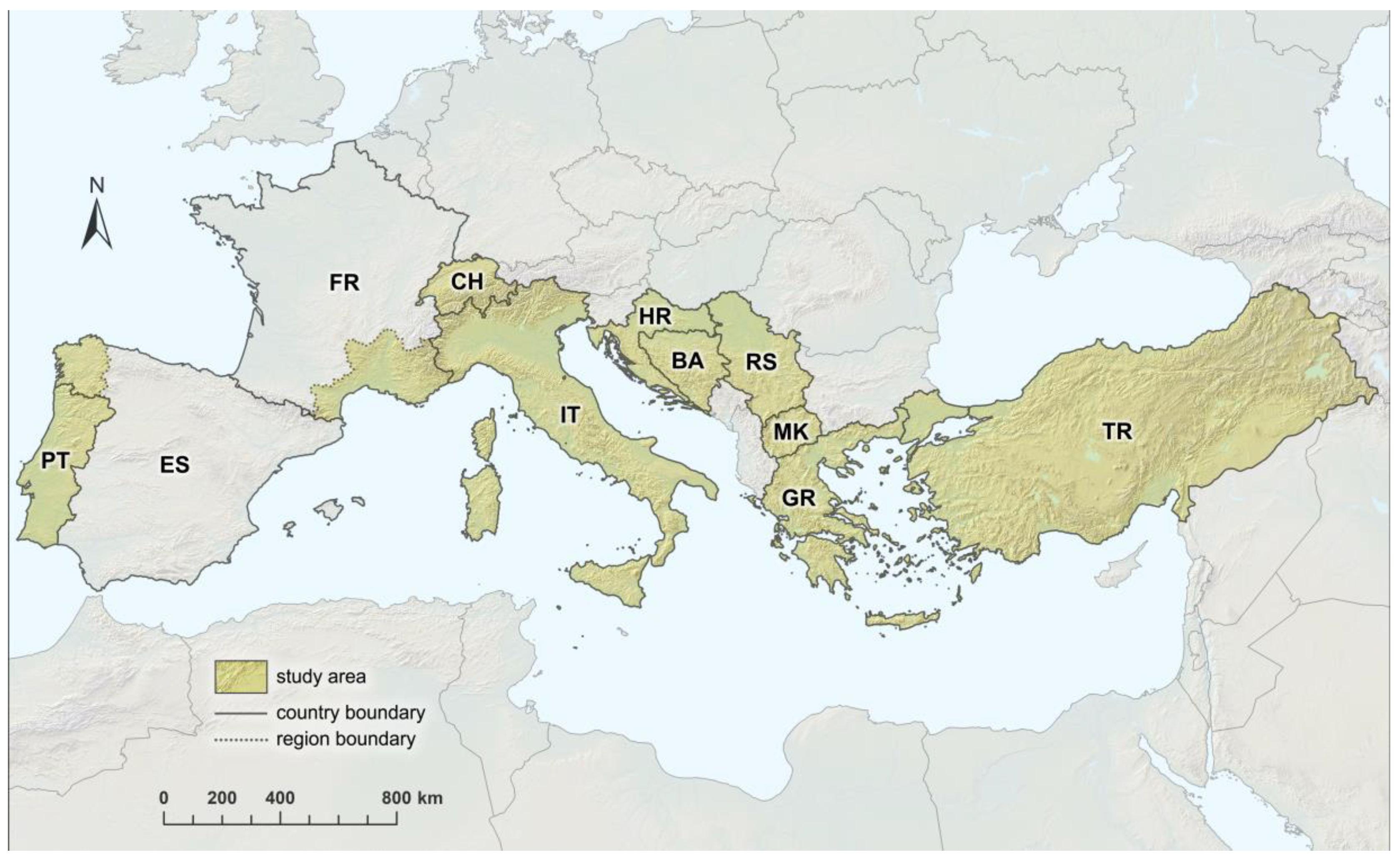
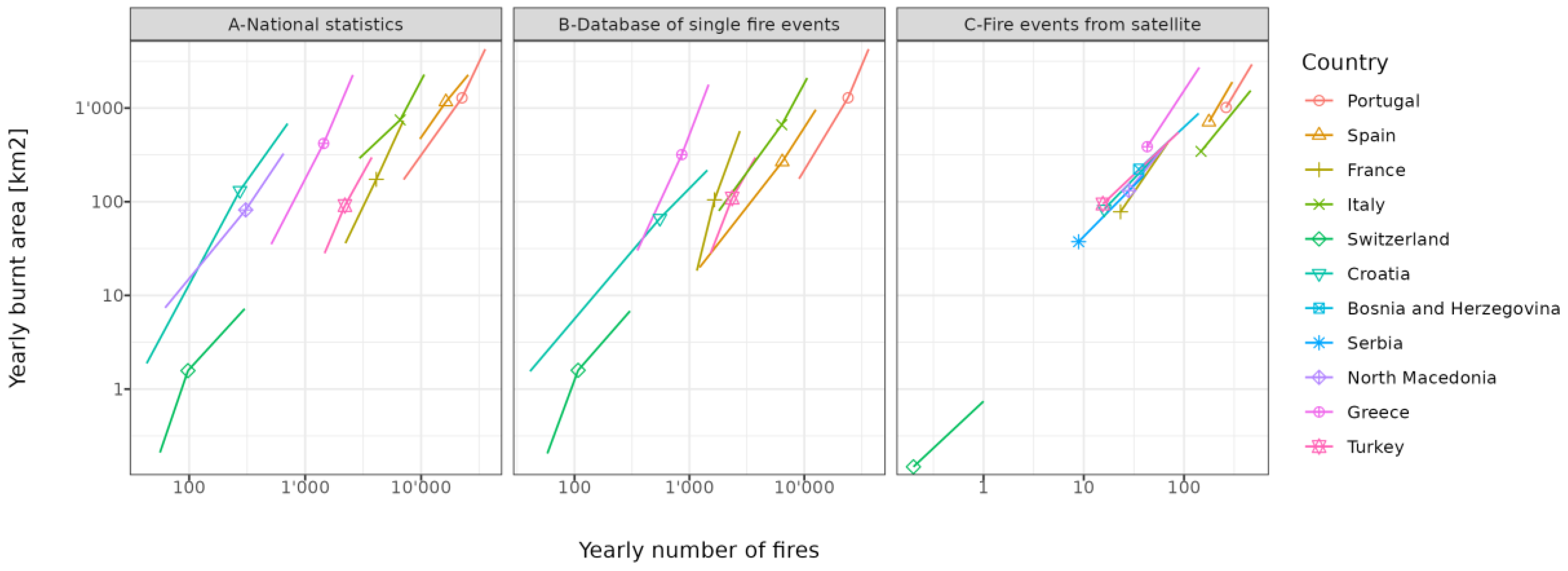
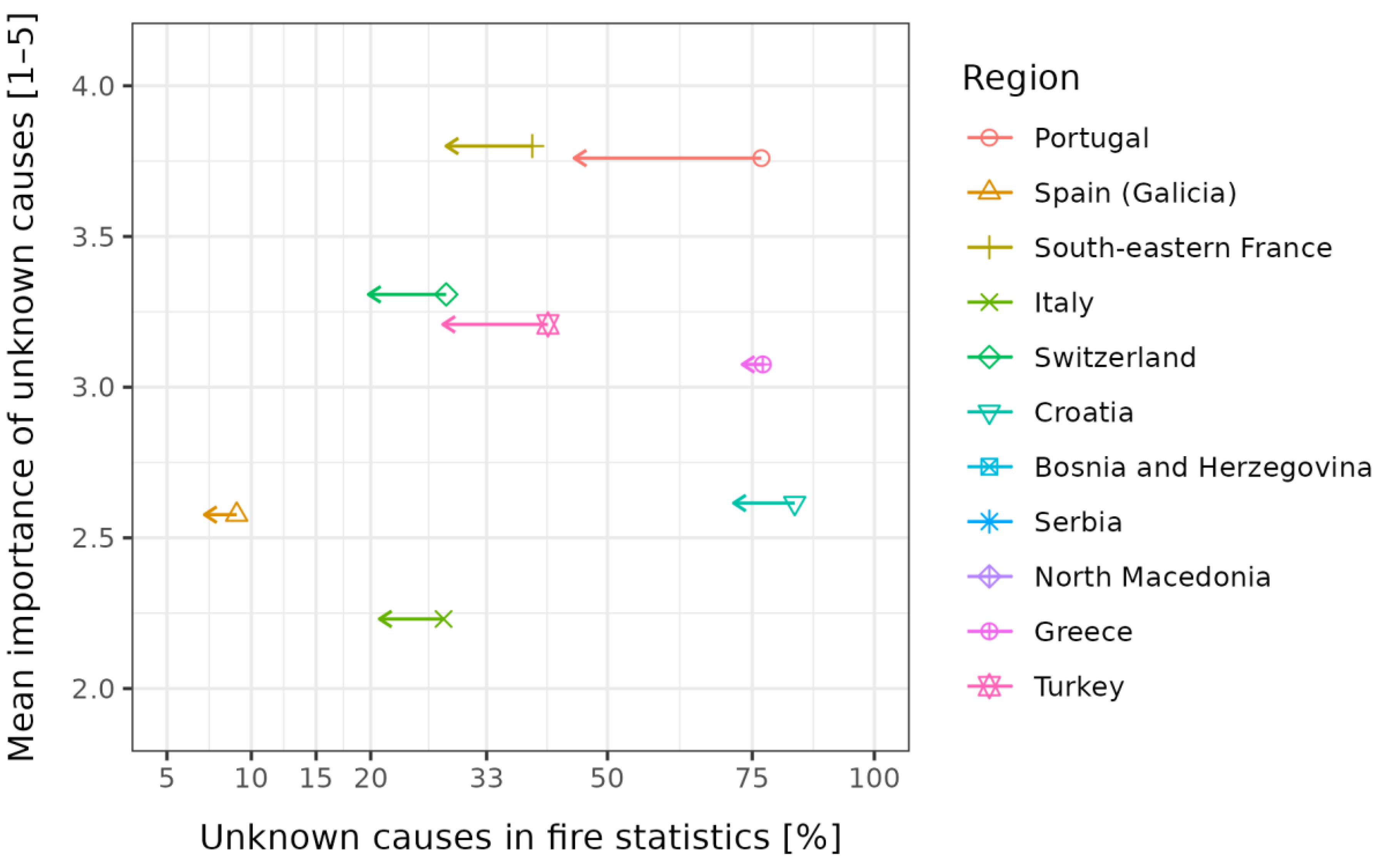
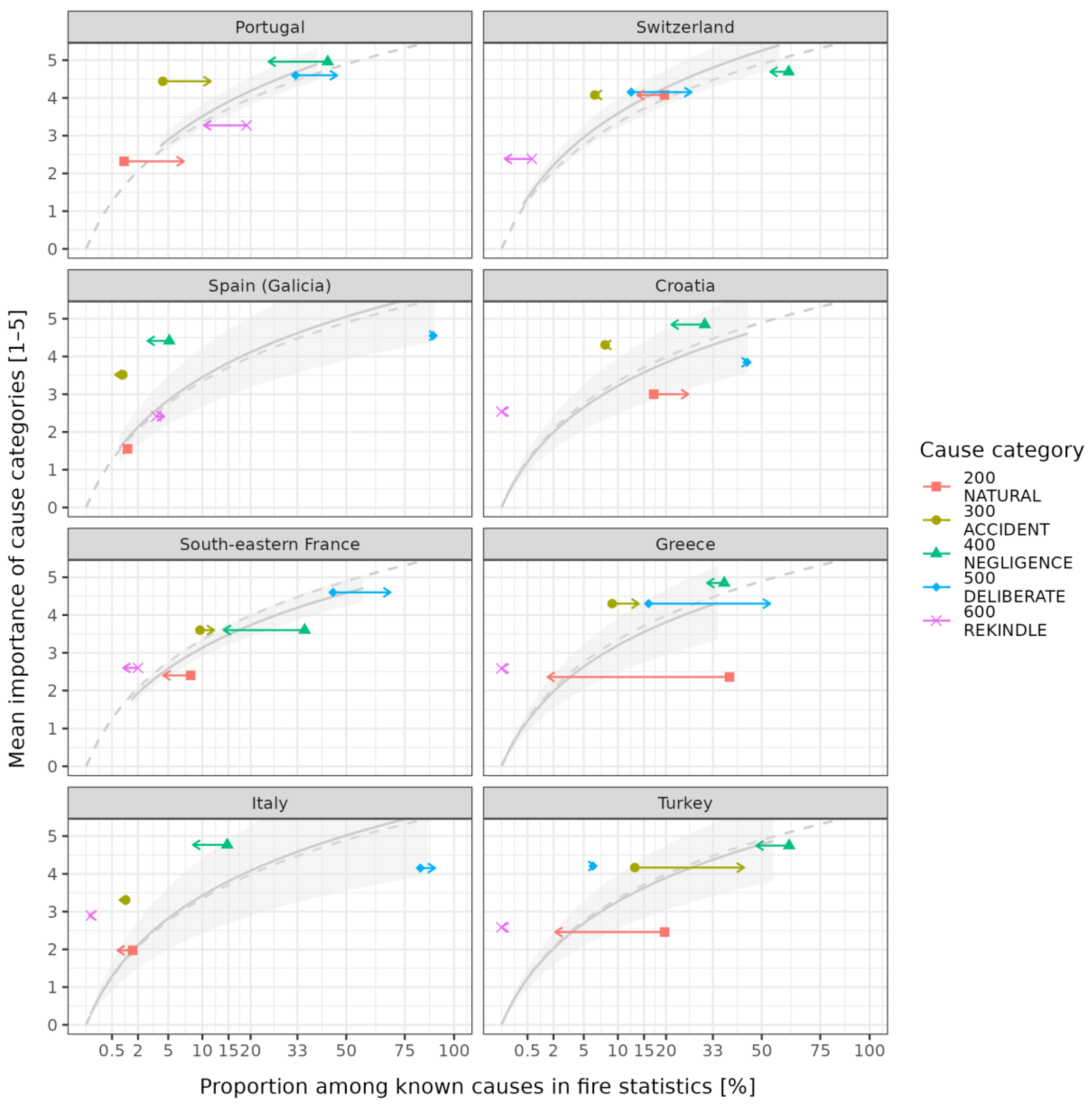

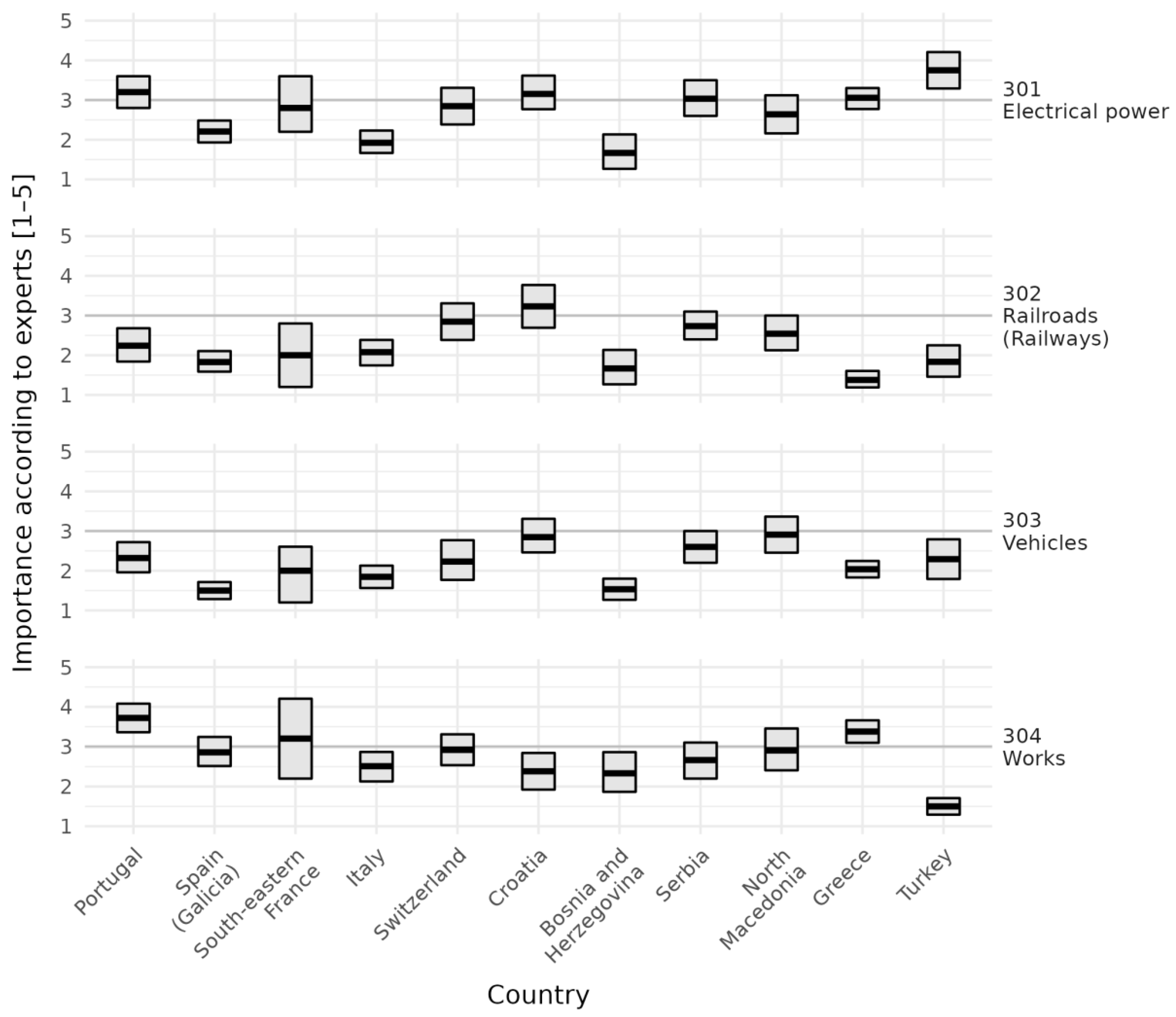
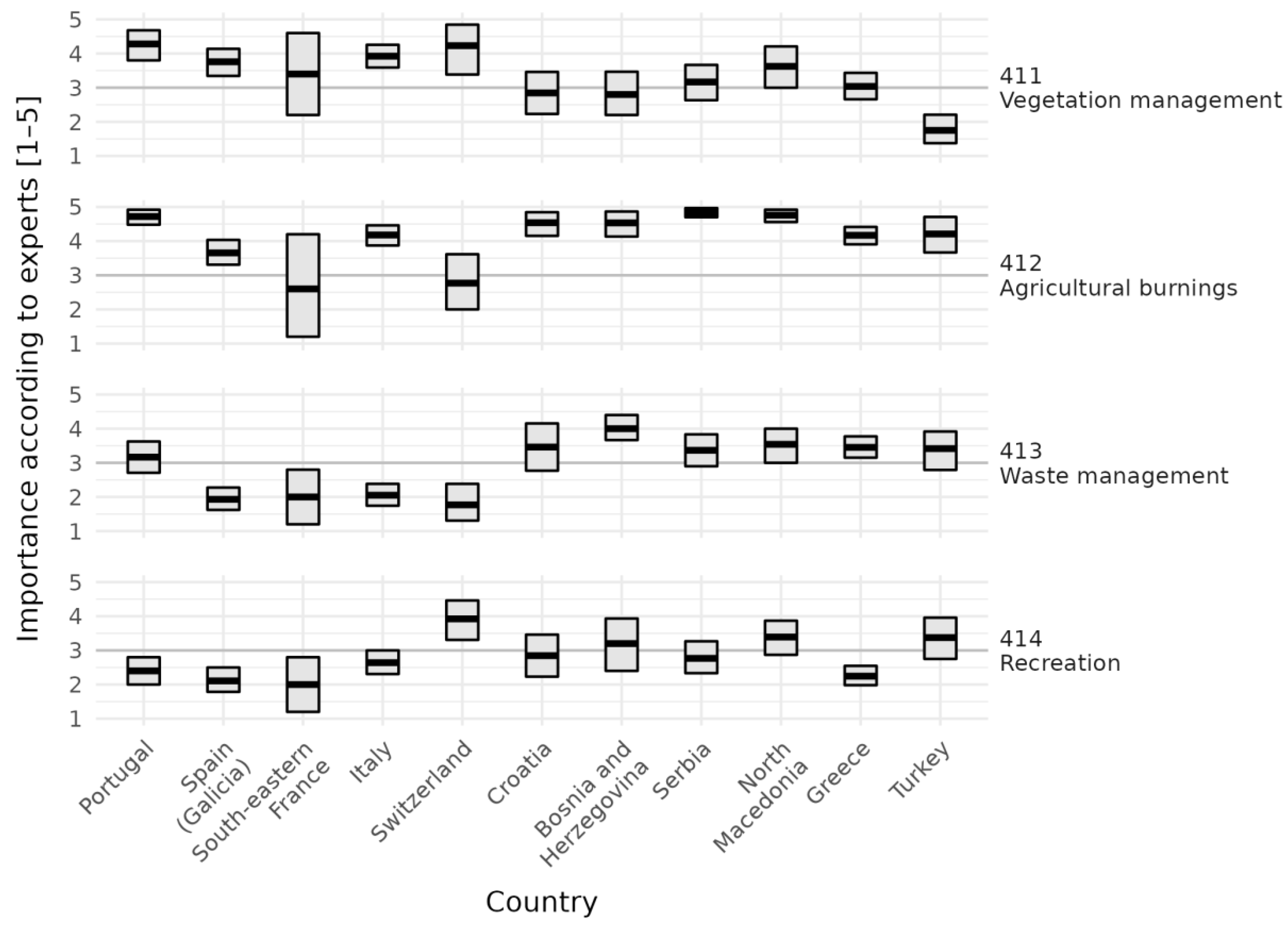
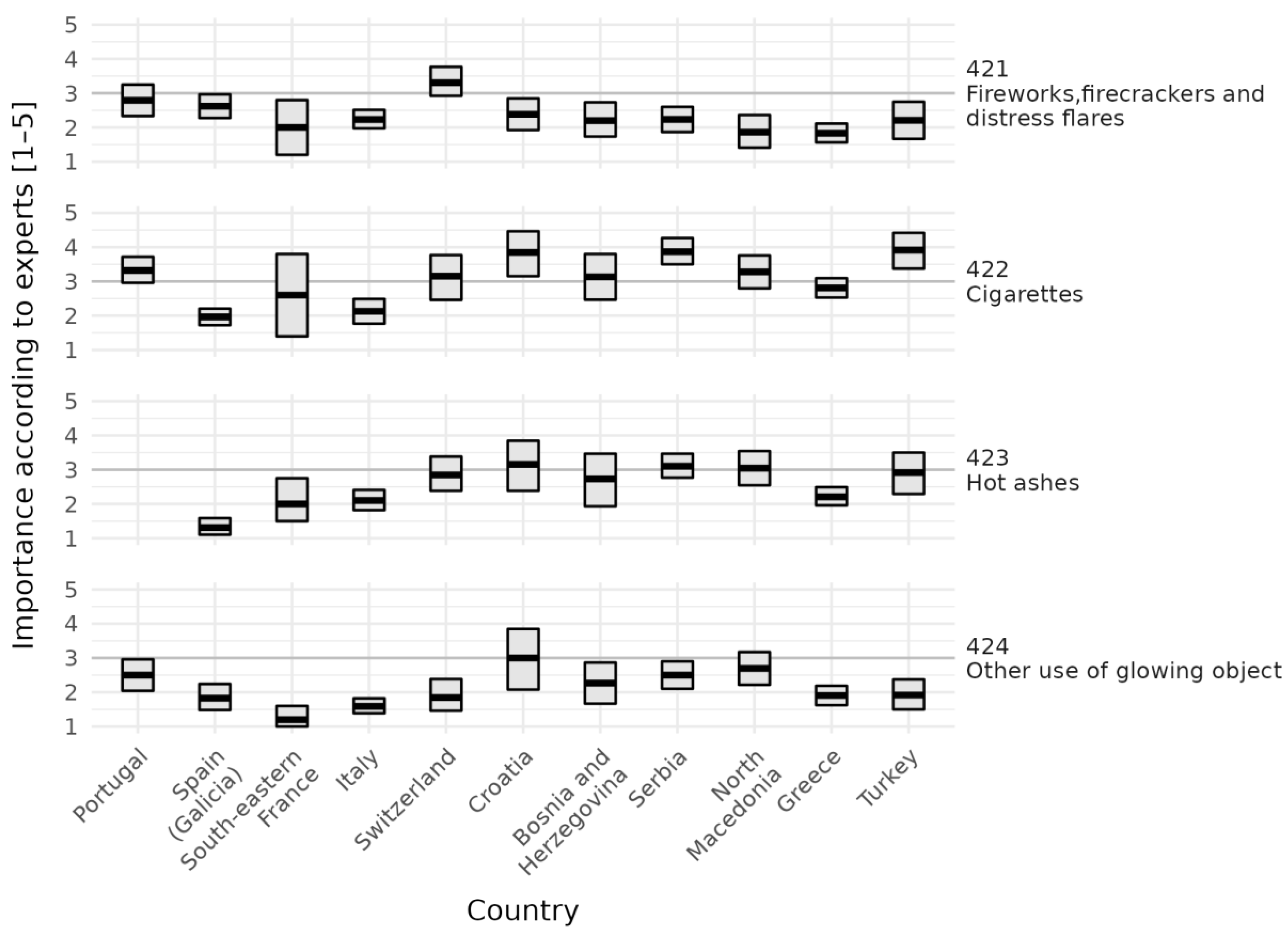

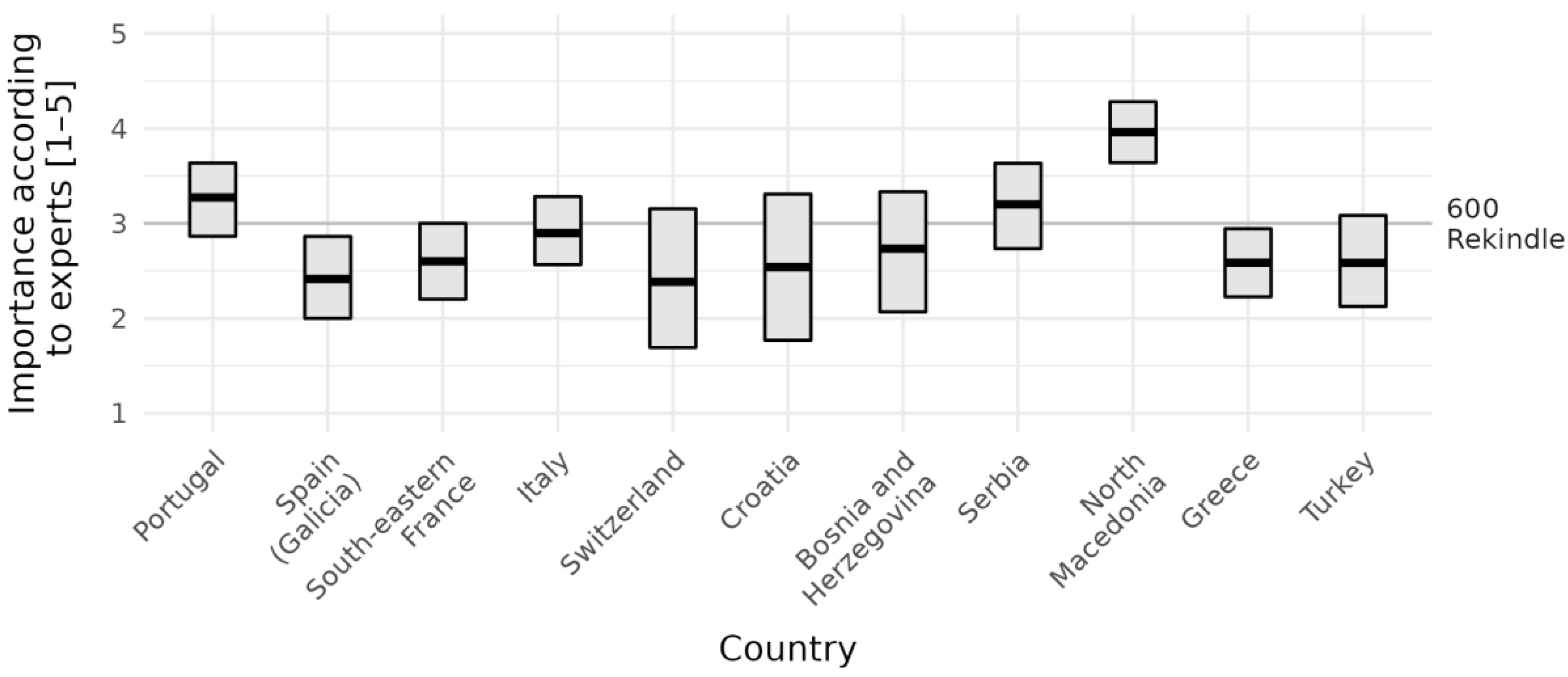
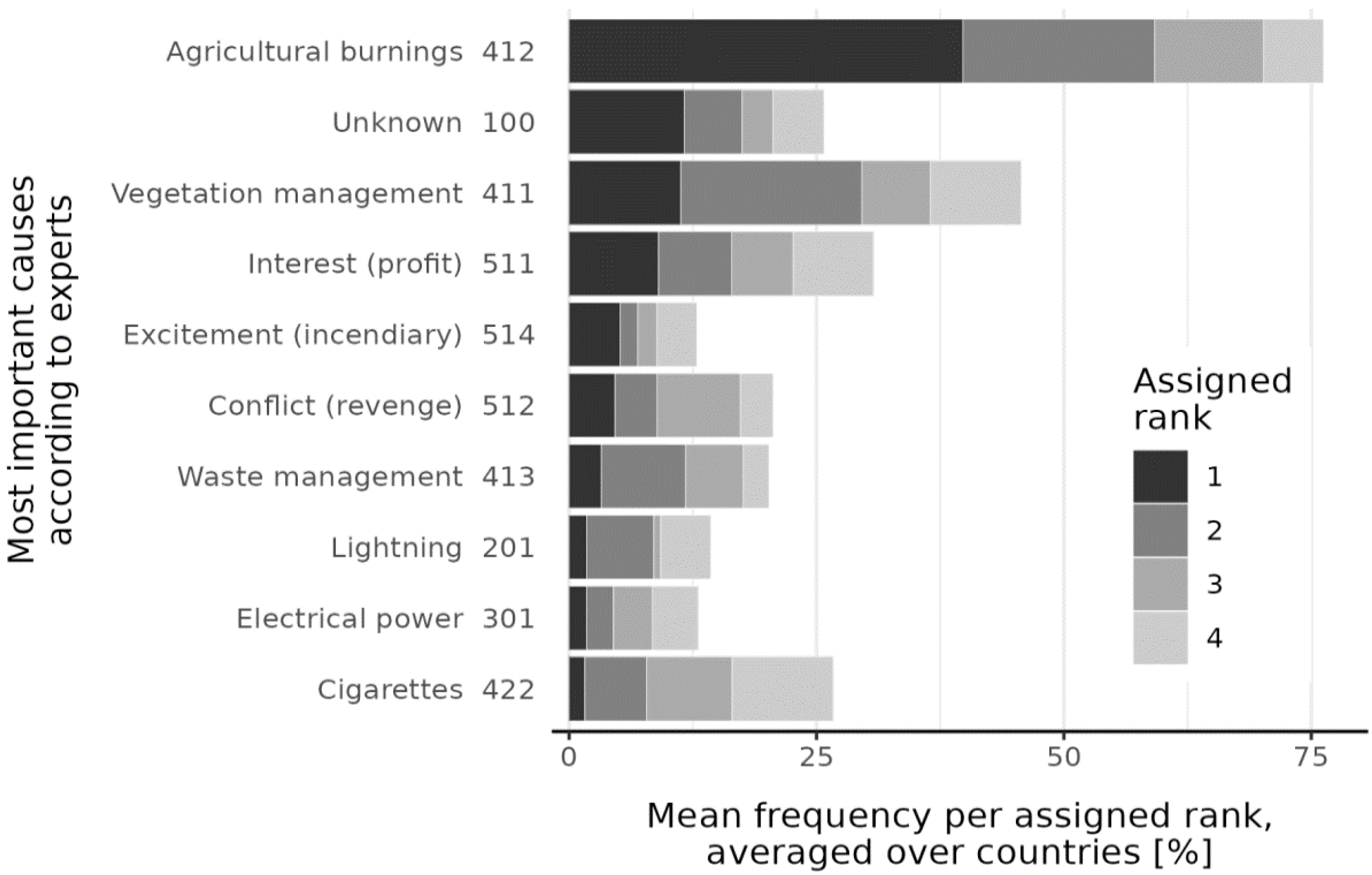
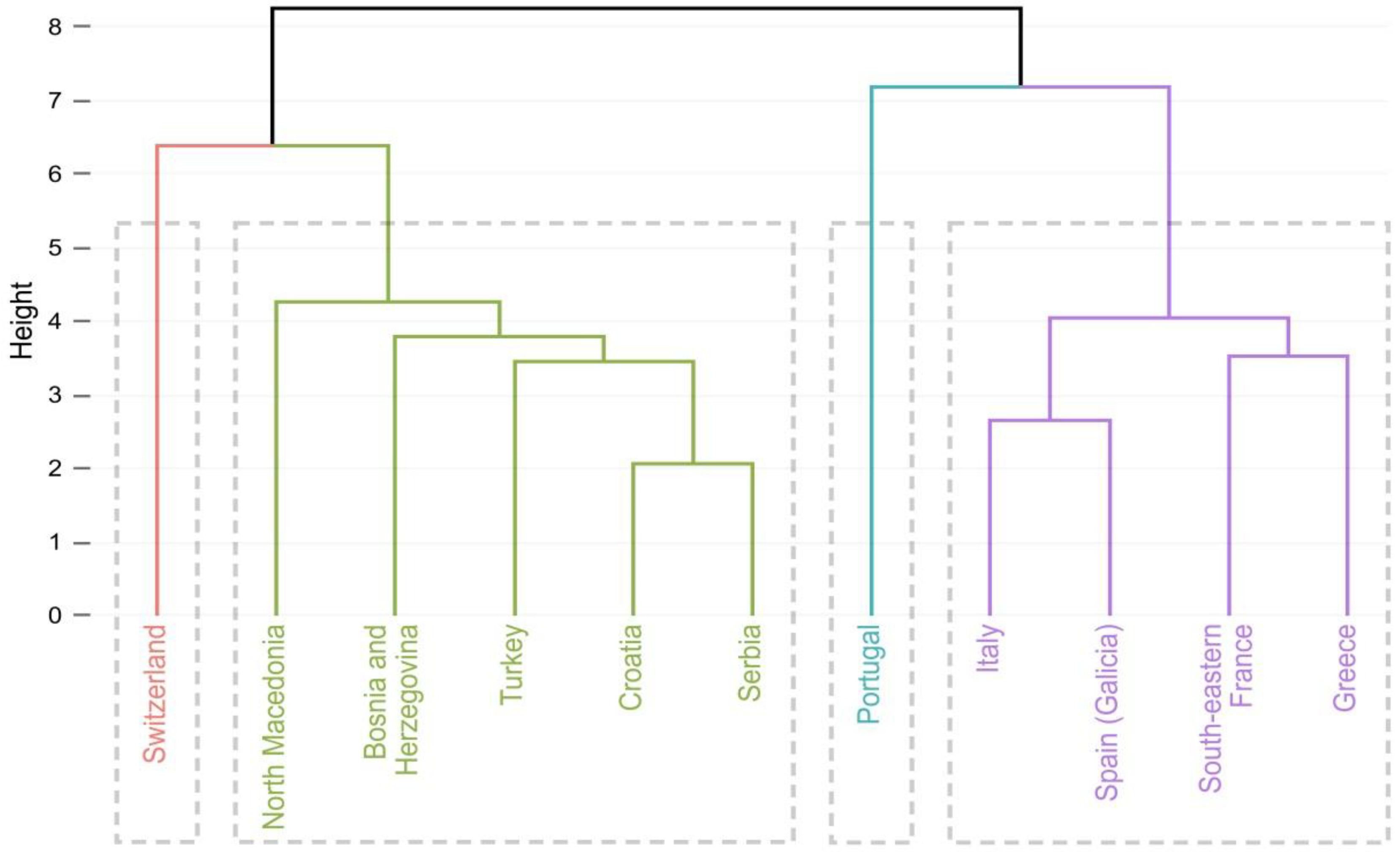
| Country | Number of Experts | Professional Status or Affiliation |
|---|---|---|
| Portugal | 25 | Fire Service, Forest Service, National Guard |
| Spain (Galicia Region) | 29 | Fire Service, “Guardia Civil” (Gendarmerie: Forest fire causes investigators and Environment Protection Service) |
| France (south-eastern France) | 5 | n.a. |
| Italy | 39 | State Forest Service (CFS-Corpo Forestale dello Stato 1) |
| Switzerland | 13 | Forest Service, Fire Service, Research Institute |
| Croatia | 13 | Forest Service, Civil Protection |
| Bosnia and Herzegovina | 15 | Forest Service, Civil Protection |
| Serbia | 30 | Fire Service, State Forest Service |
| Republic of North Macedonia | 25 | Forest Service, Civil Protection, Fire Service, Volunteers |
| Greece | 53 | Forest Service, Fire Service |
| Turkey | 24 | Forest Service |
Publisher’s Note: MDPI stays neutral with regard to jurisdictional claims in published maps and institutional affiliations. |
© 2022 by the authors. Licensee MDPI, Basel, Switzerland. This article is an open access article distributed under the terms and conditions of the Creative Commons Attribution (CC BY) license (https://creativecommons.org/licenses/by/4.0/).
Share and Cite
Tedim, F.; Leone, V.; Lovreglio, R.; Xanthopoulos, G.; Chas-Amil, M.-L.; Ganteaume, A.; Efe, R.; Royé, D.; Fuerst-Bjeliš, B.; Nikolov, N.; et al. Forest Fire Causes and Motivations in the Southern and South-Eastern Europe through Experts’ Perception and Applications to Current Policies. Forests 2022, 13, 562. https://doi.org/10.3390/f13040562
Tedim F, Leone V, Lovreglio R, Xanthopoulos G, Chas-Amil M-L, Ganteaume A, Efe R, Royé D, Fuerst-Bjeliš B, Nikolov N, et al. Forest Fire Causes and Motivations in the Southern and South-Eastern Europe through Experts’ Perception and Applications to Current Policies. Forests. 2022; 13(4):562. https://doi.org/10.3390/f13040562
Chicago/Turabian StyleTedim, Fantina, Vittorio Leone, Raffaella Lovreglio, Gavriil Xanthopoulos, María-Luisa Chas-Amil, Anne Ganteaume, Recep Efe, Dominic Royé, Borna Fuerst-Bjeliš, Nikola Nikolov, and et al. 2022. "Forest Fire Causes and Motivations in the Southern and South-Eastern Europe through Experts’ Perception and Applications to Current Policies" Forests 13, no. 4: 562. https://doi.org/10.3390/f13040562






